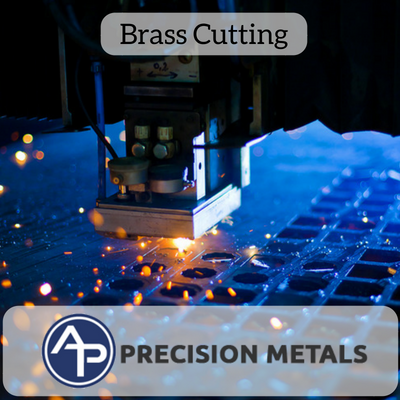
BRASS CUTTING
A Quick Guide to Brass Cutting Techniques

Brass Cutting for Sheet Metal
Several industries utilize brass sheet metal on a day-to-day basis. In automotive production, innovators are using brass alloy sheet metal to build lighter and more cost effective radiators. Machinists have long enjoyed working with brass for its consistent grain, malleability, and affordability. This material is predictable and performs well on a leigth. Trumpets and other musical instruments are made of brass because of its flexibility and acoustic characteristics. Interior designers, furniture makers, and architects all favor the rich color, durability, and timelessness of brass and brass alloys. Even antique dealers have an occasional need for brass pieces as they restore lost or broken components of vintage furniture or interior elements. Sheet metal brass cutting can be done in a few ways. At AP precision, we utilize shears, breaks, non-ferrous rotary blades, and laser-cutting to get the job done. Smaller pieces of sheet brass can be cut with a bench pin and then sanded down to eliminate and rough edges. A professional metal fabricator can instruct you on the best brass cutting method for the size and gauge of your sheet.
Non-Ferrous Rotary Brass Cutting
Metal fabricators have access to specially-designed work tables and rotary blades that are formulated to cut brass sheet in a precise and clean manner. These blades, depending the number of teeth on the blade and the thickness of the brass you intend to cut, can allow for a very clean, burr-free cut when executed by a professional fabricator. While these blades can be purchased for use on a home saw, best results will come from a quick visit to your local metal shop for a quick quote - they might even be able to process your request in the same day.
Brass Cutting for Rod and Tube
Cutting brass rod and tube is often times more simple than cutting sheet. Often, these jobs can be done neatly and effectively with a cutting piers or a rotary tool. Plumbers and other industries that work with large quantities of tube and rod will often pay a professional machinist to cut big orders of brass tube and rod. This ensures that everything is cut to a precise length, that ends are polished or reamed as needed, and that the final products are labelled and packed to help keep everything organized.
Brass Laser Cutting
The latest technology in metal fabrication uses laser cutting and CNC machines to deliver highly-precise results with little or no-need for manual sanding. In brass cutting, a high-end metal fabrication shop runs a specialized laser that’s designed to work with the reflective nature of brass and brass alloys. Although this process can be a more costly option, several manufacturers rely on this method of brass cutting to yield efficient and reliable results. For example, a large production of brass radiators or computer parts would be best executed by laser cutting, rather than the traditional, manual alternatives.